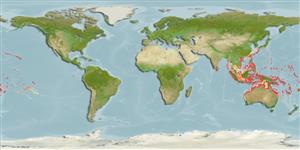Common names from other countries
Environment: milieu / climate zone / depth range / distribution range
Ecologia
marinhas associadas(os) a recifes; intervalo de profundidade 0 - 36 m (Ref. 1602). Tropical; 30°N - 30°S, 77°E - 124°W
Indo-Pacific: Sri Lanka to the Hawaiian, Marquesan and Ducie islands, north to southern Japan, south to Lord Howe and Rapa Islands; throughout Micronesia.
Tamanho / Peso / Idade
Maturity: Lm ? range ? - ? cm
Max length : 20.0 cm TL macho/indeterminado; (Ref. 9710)
Espinhos dorsais (total) : 12 - 13; Raios dorsais moles (total) : 24 - 28; Espinhos anais: 3; Raios anais moles: 20 - 23. Body is white with orange to orange-brown oblique bands on the sides. Two broad yellow-edged black bars are on the head; one running across the eye and another on the snout (Ref. 4855). Snout length 2.6-3.2 in HL. Body depth 1.3-1.6 in SL (Ref. 90102).
Occur in clear waters and coral-rich areas of lagoon and seaward reefs. However, only common in seaward reefs (Ref. 1602). Benthopelagic (Ref. 58302). Juveniles are solitary, living among branching corals, while adults are almost always in pairs and are home-ranging. Feed exclusively on coral tissue (Ref. 1602). Oviparous (Ref. 205). Form pairs during breeding (Ref. 205). Minimum depth reported taken from Ref. 128797.
Life cycle and mating behavior
Maturities | Reprodução | Spawnings | Egg(s) | Fecundities | Larvas
Distinct pairing (Ref. 205). Monogamous mating is observed as obligate, genetic and social (Ref. 52884).
Myers, R.F., 1991. Micronesian reef fishes. Second Ed. Coral Graphics, Barrigada, Guam. 298 p. (Ref. 1602)
Categoria na Lista Vermelha da IUCN (Ref. 130435)
CITES (Ref. 128078)
Not Evaluated
Ameaça para o homem
Harmless
Utilização humana
Pescarias: pouco comercial; Aquário: Espécies comerciais
Ferramentas
Relatórios especiais
Descarregue XML
Fontes da internet
Estimates based on models
Preferred temperature (Ref.
115969): 24.8 - 29.3, mean 28.4 (based on 2134 cells).
Phylogenetic diversity index (Ref.
82804): PD
50 = 0.5000 [Uniqueness, from 0.5 = low to 2.0 = high].
Bayesian length-weight: a=0.02291 (0.01133 - 0.04632), b=3.00 (2.83 - 3.17), in cm Total Length, based on LWR estimates for this Genus-body shape (Ref.
93245).
Nível Trófico (Ref.
69278): 3.3 ±0.61 se; based on food items.
Resiliência (Ref.
120179): Elevada, tempo mínimo de duplicação da população menor que 15 meses (Preliminary K or Fecundity.).
Fishing Vulnerability (Ref.
59153): Low vulnerability (10 of 100).
